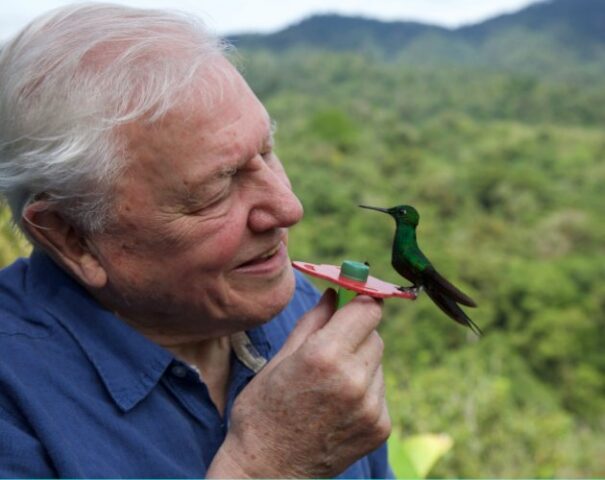Neither the Coronavirus nor the global confinement managed to prevent the renowned naturalist Sir David Attenboroughfrom filming in Costa Rica part of his new documentary “Life in Color”, which premiered April 22nd on Netflix.
Of course, the production had to be put to test deeply for challenging the treacherous Pandemic, which almost brought this project down, focused on how animals use color as a survival technique in their environment.
The production, which brought together the BBC and Netflix for the first time in a program about nature, had scheduled filming in Costa Rica, Scotland and Italy, among other places. However, plans were faltered when the global clock stopped and the entire world went into lockdown in an effort to contain the spread of COVID-19.
Fortunately, the 94-year-old British presenter and scientist had already filmed his scenes in Costa Rica, producer Stephen Dunleavy explained.That was not the case for at least ten other locations, whose filming had to be suspended due to the Pandemic.
Also, the producers had to abandon their plans to travel to Italy to film, while the nonagenarian Attenborough was secluded for his safety at his home in south-west London.
Saved by Costa Rica
In the midst of all this bad news for the production, the filmmakers knew very well that they had beautiful shots made in Costa Rica in which Attenborough was seen surrounded by hummingbirds, macaws and toucans, among other animals. They also knew that somehow they had to rescue the project.
David Attenborough has traveled the world to collect all its wonders and raise his voice in favor of the conservation of the planet. During the trip to Costa Rica the conservationist was very cheerful while filming.

Joie de vivre
“He was 92 or 93 when we shot it, but he looked like someone 60 or 65. He always looks more jovial. It is always great to be on location with him because he feels that joie de vivre and that is really attractive. There is a real curiosity, not only of where he is and what he sees, in reality it is a curiosity of everyone around him”, recalled the producer.
At first they thought about postponing production altogether, but they decided to continue. That involved choosing new locations closer to home, to take care of Attenborough’s health. In this way, scenes planned to be filmed in flowered meadows in Italy were changed to a field of flowers in Richmond Park, located about 40 minutes from central London.
For this reason, instead of the three original chapters that were planned for the BBC, only two were delivered, which premiered on that British channel on February 28th.
In the case of Netflix, Dunleavy assured that the documentary will be divided into three parts, instead of the four planned at the beginning, and will premiere on that platform on Thursday, April 22nd, to coincide with the commemoration of Earth Day.
World of colors
As the producer explained, Attenborough has always shown a special interest in color, which is why this project holds a special place in the heart of this pioneer of natural documentation.
In Life in Color, therefore, you can see up close how that great passion for nature is reflected on the screen. “David Attenborough travels the world from the rainforest of Costa Rica to the snow-capped mountains of Scotland to reveal the extraordinary and never-before-seen way animals use color,” reads the Netflix synopsis of this documentary.
To achieve this, cameras with revolutionary technology created specifically for this documentary series were used. “Viewers will be able to experience how colors invisible to the human eye play a vital role in the interaction of animals,” explain the production notes.
From the ultraviolet signals, which look more like magic on butterfly wings, to the surprising but especially crucial stripes of the Bengal tiger, there is a whole world of colors waiting to be discovered.
Life in Color comes after the overwhelming success of other recent documentaries with the participation of Attenborough, such as Our Planet (2019) and A Life on Our Planet (2020), in which the naturalist raises his voice in favor of the conservation of our environment.
It is a very personal struggle that began in 1979, with the broadcast of his first television series for the BBC, Life on Earth, but which began to take shape when he was a child who loved fossil insects and later a young geology student and zoology.More than 40 years later, Attenborough says he is honored that younger generations are interested in hearing what he has to say to save the planet.

